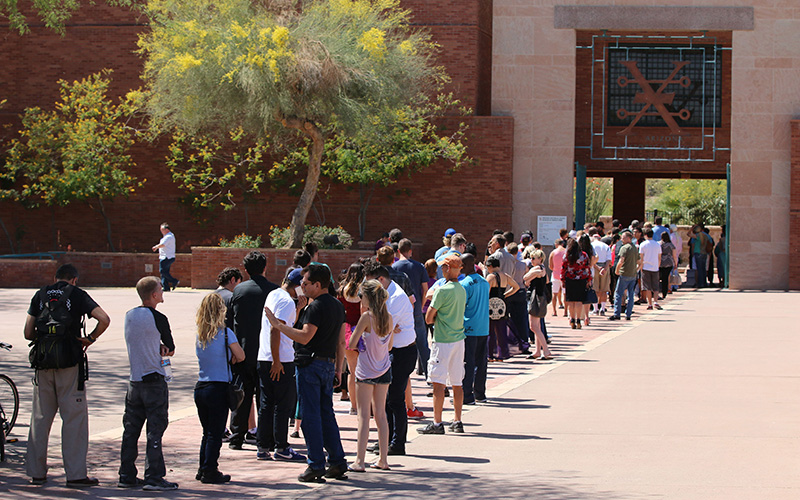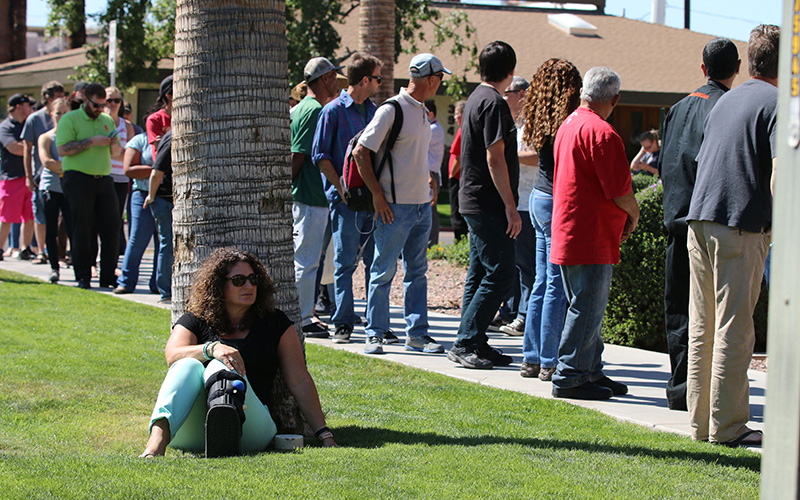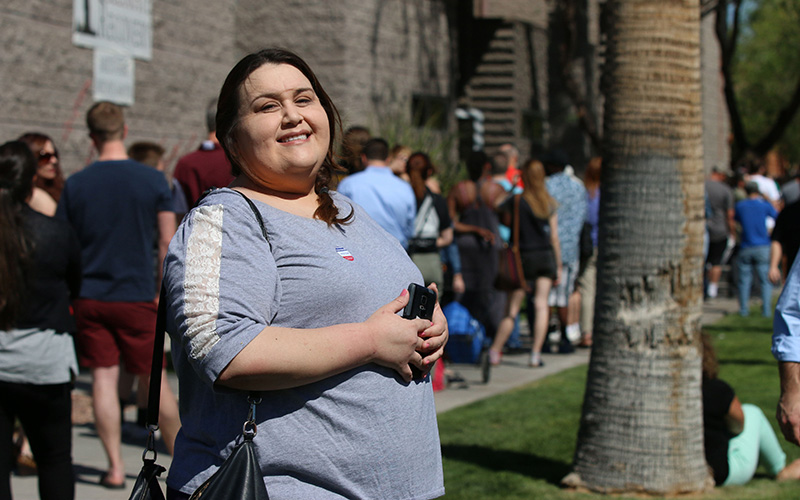School teacher Luz Magallanes regularly votes in-person so she can share her experience with her students.
On March 22, Magallanes attempted to vote in the Presidential Preference Election at the American Legion polling place in Chandler before school hours, but the wait was too long. She returned to the polling place at 6 p.m. that night and waited in line 5 hours before casting her ballot.
Marcia Baker also waited five hours in line at the Shiloh Community Church in north Phoenix, but was unable to cast a ballot because a poll worker told her she was not in the registration database. Baker was forced to cast a provisional ballot. She called the Maricopa County Recorder’s Office the following day and a representative confirmed she was a registered Democrat.
Magallanes and Baker are plaintiffs in the lawsuit filed by the Democratic National Committee because they were burdened by Maricopa County’s mismanagement of the election and fears the same experience in the upcoming elections, according to court documents.
On April 19, the DNC filed a lawsuit against the state of Arizona to protect the right to vote and prevent the continued disenfranchisement of thousands of Arizona voters, according to court documents.
The lawsuit continues on to state, “…specifically Arizona’s Hispanic, Native-American, and African-American voters whose right to vote has been and will continue to be denied or unreasonably infringed upon due to the lack of oversight for Maricopa County’s allocation of polling locations; Arizona’s practice of not counting provisional ballots cast in a precinct or voting area other than the one to which the voter was assigned; and the State’s recent criminalization of the collection of signed and sealed absentee ballots with the passage of H.B. 2023.”
Since March 22, both the Maricopa County Recorder’s Office and Secretary of State Michele Reagan have admitted that what happened that Tuesday was a mistake.
On March 23, Reagan called for a statewide review of the county’s election policies and procedures.
“Obviously, in retrospect, it was not enough, clearly,” said Elizabeth Bartholomew, communications manager for the Maricopa County Recorder’s Office. “And it wasn’t enough just necessarily in minority areas, it wasn’t enough anywhere.”
According to the county recorder’s office, there were 24,639 provisional ballots cast. Of that, only 4,631 ballots counted. The 20,008 ballots that did not count were invalid because the voter was not eligible either due to being registered independent or no party affiliation or being registered after the deadline.
Bartholomew has yet to respond to reasons why the other 1,686 ballots were not accepted.
Presidential candidates Donald Trump and Hillary Clinton were announced winners before some voters were out of line.
“We have heard the argument that a lot of people say that their voter registration was unknowingly changed,” Bartholomew said. “I don’t really know how that would happen because there was no glitch in the system, no hack in the system, nothing to that matter.”
Voters waited up to five hours in line at some of the 60 polling places open for the Presidential Preference Election. While the recorder’s office placed some blame on independent voters showing up at the polls, others attributed the wait to the 70 percent reduction in polling locations.
Patrick Kenney, dean of the College of Liberal Arts and Sciences at Arizona State University, said the reduction in polling place locations had the “unintended effect on putting a significant burden on the voters’ ability to vote.”
Some voters and advocates accused the Maricopa Elections Department of voter suppression.
“Two and a half hours to be in line, it’s going to be a hardship,” said Alicia Contreras, a volunteer with Promise Arizona, a voting advocacy group aimed at increasing Latino turnout. “We’ve also seen people actually exit the line. So it’s very unfortunate that this is happening.”
This is the first election cycle where Section 5 of the 1965 Voting Rights Act is not in effect. Section 5 would require federal approval of any change to the election procedures.
On June 25, 2013, in the decision of Shelby County v. Holder, the U.S. Supreme Court held that no preclearance was necessary for voting changes.
According to the U.S. Department of Justice, “Section 5 was designed to ensure that voting changes in covered jurisdictions could not be implemented used until a favorable determination has been obtained.”
Kenney said he believes the reduction in polling places would not have happened if Section 5 was still intact.
Arizona still has three elections coming up: the Special Elections on May 17, the Primary Election on Aug. 30, and the General Election on Nov. 8.
In order to alleviate the long lines for the upcoming elections, the Maricopa County Elections Department is planning on more than doubling the number of polling places for the special and primary elections.
She said, as of now, there are 160 polling places confirmed for the May election. For November, the county elections department plans to go back to the number of polling places available in 2012’s general election, which was 724.Even still, for the 2008 general election, which is arguably more comparable to the 2016 presidential race than the 2012 election, there were 1,142 polling places in Maricopa County.
“Given their latest error, the safest thing for everyone to do is to put the same number of polling places they had in 2008,” said Kenney.
Bartholomew said a polling place is required in every precinct by an Arizona state statute and that after 2008 the number of precincts changed from 1,142 to 724 though legislation.
Kenney said there are other problems in Arizona’s election procedures that cost money and negatively affect turnout. He said the closed primaries and the 30-days in advance registration are hurdles to Arizona voters.
He also said the election process would be better if the state legislature combined the Presidential Preference Election and the August primary.
“States that [have two primaries], incur extra costs,” he said. “We have our primaries so late that it’s not relevant to the Presidential race … Turnout would increase if you put it all on one day. There’s a lot of evidence that shows that and it would be cheaper.”
Maricopa County congressional district population breakdownInfographic
Maricopa County congressional district population voting turnoutInfographic


